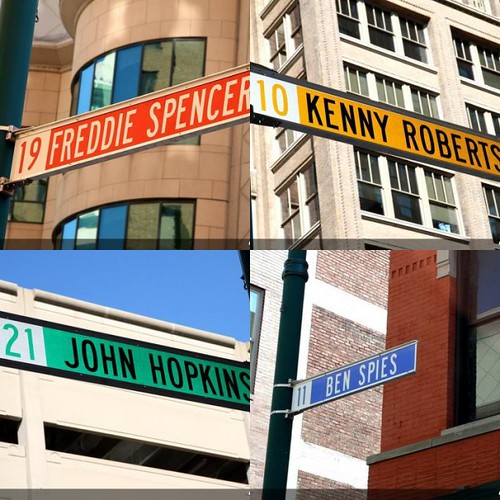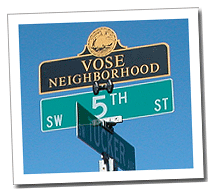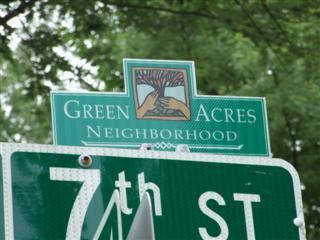Another way to think about wayfinding in DC
I am going to write a longer piece on this subject sometime within the next few weeks but this comes out of a conversation on Sunday (we had people over).

We were talking about street signs and wayfinding signage because I showed off the book by Daniel Gibson to Christopher, who is the designer of "my" proof of concept signs for "intra-district" directory wayfinding signage.
I said hmm, maybe the street signs for each quadrant in DC (NW, NE, SW, SE) could be a different color.

Mosaic created with fd's" Flickr Toys. Original images are street signs honoring automobile and motorcycle racers, in Indianapolis, home of the Indianapolis Speedway race track. Images from motogp.com
But then yesterday I thought about this a bit more deeply. There are four things we could try to communicate through street signs in DC:
1. Quadrant;
2. Direction;
3. Neighborhood;
4. Historic District.
Direction. Numbered streets are north-south and lettered streets are east-west. Why not make north-south street signs one color and east-west signs another color? Avenue streets could remain green.
Neighborhoods. I have always liked how Pittsburgh indicates the neighborhood on street signs at major intersections.

Street signs on the border of the Bloomfield and Lawrenceville neighborhoods, Pittsburgh.
Other cities, such as Bloomington, Indiana or Beaverton, Oregon, allow for sign toppers, on street signs within neighborhoods, not just for major intersections.

Vose neighborhood sign, Beaverton, Oregon. (City of Beaverton image.)
Historic Districts. I think this is important. It happens that I think the DC street signs signifying historic districts are hideous. And I think they should be on every street corner anyway.

I think sign toppers are more elegant than the current system.

Green Acres neighborhood, Bloomington, Indiana. (City website image.)
If I had to choose between signifying quadrants through specific colors or north-south and east-west directional signs, I would choose the latter.
And yes, 5-8% of men and 1% of women are color blind. So by putting N and W indicators on the street signs, you can provide information for people who are color blind.

Petersburg, Virginia color codes street signs according to historic district. So street signs in Old Towne are brown, in Courthouse are blue, etc.
Labels: wayfinding



0 Comments:
Post a Comment
<< Home